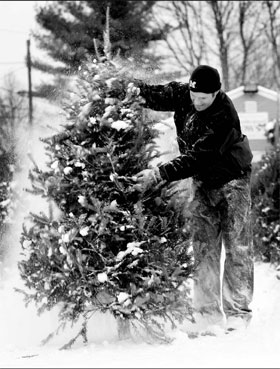Drooping dollar saps tree growers
The drooping value of the US dollar means Canadian Christmas tree growers are seeing less green this season.
Canadian Christmas tree growers have seen their US sales decline in recent years because of increasing costs and competition from US growers.
|
A man shakes snow from a Canadian-grown tree for sale in South Portland, Maine. AP |
But it's their own currency that's causing them the most grief these days.
Compared to the US greenback, the Canadian dollar is 15 percent higher in value than it was at the beginning of the year.
Because growers are paid in US dollars, their revenues are dropping by the same amount.
Canadian exporters of products ranging from seafood, lumber and auto parts to Canadian Club whiskey are all suffering a similar fate. But Christmas trees are an especially visible example at this time of year.
Out of business
The situation is blamed for driving Canada's largest Christmas tree grower, Nova Scotia's Kirk Forest Products, out of business.
"That put the dagger to the heart," said the company's founder, Rick Kirk, who is shipping about 250,000 trees, most of them to the United States, in his company's final holiday season.
"We know that the market is going to be squeezed year after year."
More than half of Canada's Christmas trees are shipped to the US, but the figure has dropped by about 20 percent, to about 2 million trees, since 2002.
During that period, the value of the Canadian dollar grew by about 50 percent.
The effect on US consumers is minimal because Canadian trees account for less than 10 percent of the total number of trees sold.
This season, the average purchase price for a live Christmas tree in the US is expected to be similar to last year's average of $40.50, said Rick Dungey of the National Christmas Tree Association in Chesterfield, Missouri.
While the exchange rate is bad for Canadian exporters, it is a boon for US retailers because Canadians are flocking across the border this month to shop.
All probably thought they had seen the peak last summer when the Canadian dollar - called the loonie - reached a 28-year high against the greenback.
But the loonie's value has continued to grow, reaching levels not seen since the US Civil War 140 years ago, said Michael Woolfolk, senior currency strategist with the Bank of New York Mellon Corp in New York.
All-time high

The Canadian dollar surged to an all-time high of $1.10 against the greenback in November, a gain of 28 percent from January 1, before falling back a bit.
In dollars and cents, a Canadian grower who receives $20 for a tree would have pocketed C$23.30 last December.
This month, the same $20 per tree translates to about C$20.20, a drop of about $3.
"It erases our profits, or very close," said Larry Downey of Cookshire-Eaton, Quebec, president of the Canadian Christmas Tree Association.
The problems for Canadian Christmas tree growers began in 2002, about the same time the Canadian dollar began rising in value.
Since then, Canadian tree exports to the US have declined about 20 percent to 2.1 million trees last year.
Some Canadian growers have protected themselves to some degree by entering into futures contracts that are based on currency.
For the rest, the only other choices are to ride it out and hope for better times or get out.
Agencies
(China Daily 12/12/2007 page16)















